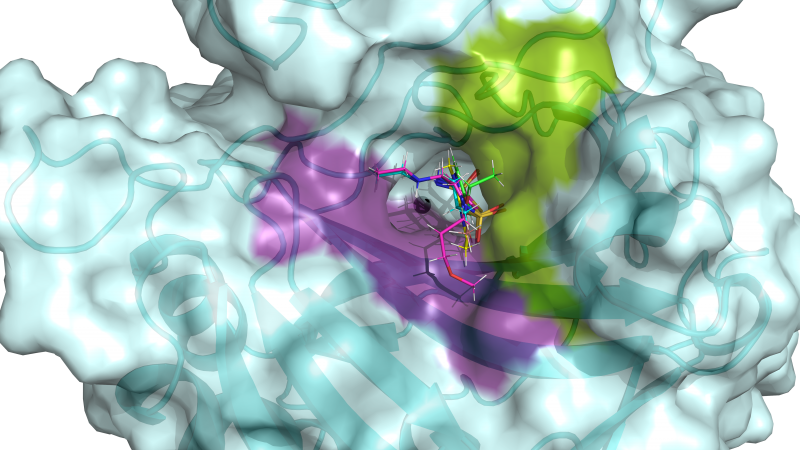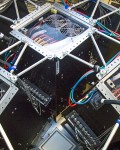Media Contact
Kelley Smith, Communications
SmithKS@ornl.gov, 865.576.5668
OAK RIDGE, Tenn., Feb. 12, 2018 – New insights from neutron analysis of glaucoma drugs and their enzyme target may help scientists design drugs that more effectively target aggressive cancers.
A team of researchers led by the Department of Energy’s Oak Ridge National Laboratory used neutron macromolecular crystallography to investigate the different states of three glaucoma drugs as they interact with the targeted enzyme, human carbonic anhydrase II (hCA II).
“Our goal was to observe differences in the presentation of three clinically used glaucoma drugs while they are bound to the hCA II enzyme,” said Andrey Kovalevsky, an instrument scientist at ORNL and a senior co-author of the study. “By looking at how well these drugs target hCA II in protonated, neutral and deprotonated states, we hoped to obtain insights that would make it possible to improve these medicines so they can better target enzymes linked to cancer.”
Protonation refers to the presence, addition or loss of a proton, which gives the drug a neutral, positive or negative charge, respectively. Altering a drug’s charge could change its ability to recognize and bind with its target protein and consequently, its effectiveness.
The study, published in the journal Structure, found that temperature, pH, and the electrical charge of the three glaucoma drugs affected their ability to target and bind with the hCA II enzyme.
“This discovery was really a proof of principle for us,” said Robert McKenna, a professor at the University of Florida and a senior co-author of the study. “It opened our eyes to how changes in temperature and pH can impact the protonation state of the drug, which in turn makes it more or less effective.”
New information about the hydrogen-bonding networks that make up the active site of hCA II may help other scientists develop new and better drugs for cancer treatment. The family of hCA enzymes contains similar proteins, such as hCA IX and XII, that are associated with aggressive breast cancers, such as triple negative breast cancer.

Three-dimensional structures of the clinical drugs brinzolamide (BZM, left) and
dorzolamide (DZM, right) as observed in the hCA II active site. The red arrow
shows the amino groups of the drugs: in BZM, the nitrogen atom (in blue)
is not protonated and thus not charged; in DZM, the nitrogen atom
has accepted an extra proton and thus is positively charged.
(ORNL/Andrey Kovalevsky)
“We want to exploit the difference in charge, pH and temperature to see if we can design drugs that are more effective at targeting these enzymes,” said Kovalevsky. “If we can understand binding at the atomic level, we can redesign drugs and turn them into stronger and more selective ‘magnets’ that will be attracted to cancer-associated enzymes. Such drugs would be much more effective at killing cancer cells while leaving healthy cells unhurt, which significantly reduces side effects for patients.”
Many scientists have used X-ray crystallography to analyze the structures of hCA enymes, but these studies lack complete atomic information on drug binding because of X-rays’ inability to visualize hydrogen atoms abundant in proteins and enzymes.
Neutrons are sensitive to lighter elements, so they provide much more detailed information on the location of hydrogen atoms. Seeing hydrogen is critical to studying protonation states of an enzyme and ligand—a molecule that binds to a biological macromolecule—and to analyzing the architecture of hydrogen-bonding networks. Neutrons also offer other experimental advantages.
“When you use neutron diffraction you don’t have radiation damage, so you can do your study at room temperature,” said McKenna. “In addition, freezing crystals may alter the drug and enzyme, introducing a false view into the study, while room temperature studies more closely resemble the environment the drug will be used in.”
Along with Kovalevsky, the paper’s coauthors include Hector Velazquez, Matthew J. Cuneo and Kevin L. Weiss of ORNL; Mayank Aggarwal of ORNL and the Shull Wollan Center; Jeremy C. Smith of the University of Tennessee and ORNL; Matthew P. Blakeley of the Institute Laue-Langevin; S. Zoë Fisher of the European Spallation Source and Lund University; and Robert McKenna of the University of Florida.
The research was funded in part by the ORNL Shull Fellowship held by Mayank Aggarwal. Neutron crystallography was performed on the MaNDi instrument at the Spallation Neutron Source, a DOE Office of Science User Facility, and on the LADI-III instrument at the Institut Laue Langevin.
ORNL is managed by UT-Battelle for DOE’s Office of Science. The Office of Science is the single largest supporter of basic research in the physical sciences in the United States and is working to address some of the most pressing challenges of our time. For more information, please visit http://science.energy.gov/.









